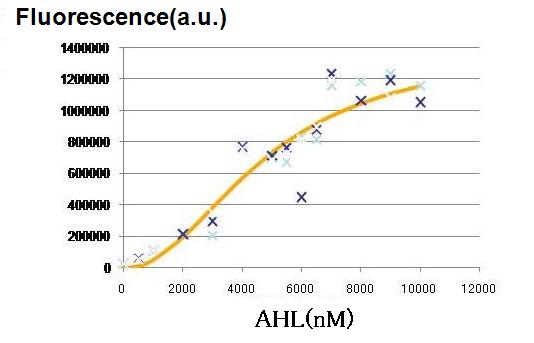Tokyo/AHL assay
From 2007.igem.org
(→Procedure:) |
(→Samples:) |
||
| Line 11: | Line 11: | ||
===Samples: === | ===Samples: === | ||
| - | Pos. con. | + | <br>Pos. con. |
| - | Neg. con. | + | <br>Neg. con. |
| - | Lux lac hybrid promoter | + | <br>Lux lac hybrid promoter |
<!--<br>hybrid promoter plasmid with pTrc99A | <!--<br>hybrid promoter plasmid with pTrc99A | ||
Revision as of 11:07, 25 October 2007
Works top 0.Hybrid promoter 1.Formulation 2.Assay1 3.Simulation 4.Assay2 5.Future works
Purpose of this assay 1.AHL assay 2.IPTG assay Preliminary assays
AHL assay
Purpose:
To check how AHL activates the newly devised lux-lac hybrid promoter
Samples:
Pos. con.
Neg. con.
Lux lac hybrid promoter
Procedure:
prepare overnight culture for each sample
make fresh culture
take 3 ul of the overinight culture into 3 ml of LB (+ Amp and Kan) in Falcon tubes.
incubate for 2 to 3 hours until the observed OD is around 1.2 (Falcon tube = 14 mm in daimeter)
add AHL & IPTG solution
The final concentration of AHL (in 3 ml LB culture) = 0, 500, 1000, 2000, 4000, 5000, 5500, 6000, 6500, 7000, 8000, 9000, and 10000 nM
(*The same amount of DMSO, solvent for AHL, was added to each sample.)
incubate for 2 to 3 hours
apply 150 ul of samples into 96-well plaste
FLA measurement
Result & Conclusion:
As the concentration of AHL increases, GFP fluorescence increased, indicating that the hybrid promoter’s activation is strengthend with increasing concentration of AHL. From the activation graph in Fig. 2, the characteristics of the hybrid promoter expressed in Hill function, such as (n2,K2), is determined.

